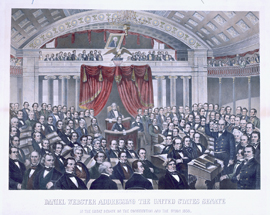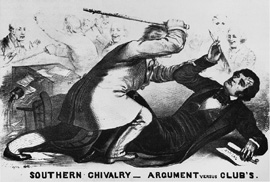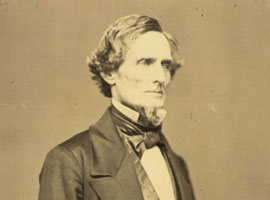How Did the Issue Admitting California to the Union In1850 Again Rasie the Debate Ovver Slavery
The Road to State of war
Disharmonize and Compromise
Sectional disputes dominated debate during the flow between the Missouri Compromise of 1820 and the Compromise of 1850 and brought to the Chamber a group of talented legislators and powerful orators. In the Senate, where the Constitution established an equality of states, there existed a delicate rest between North and South, slave and free states. For many years, senators crafted legislation designed to resolve exclusive conflicts and avoid secession and ceremonious war. In the 1850s, nevertheless, further efforts at compromise failed. The Senate endured a vehement and turbulent decade that propelled the nation to the brink of war.
The rapid expansion of the nation, as settlers moved west and new territories applied for statehood, repeatedly raised the upshot of slavery. The Constitution immune slavery to exist in the states but left Congress to make up one's mind its condition in the territories. The Northern states, having abolished slavery, sought to prevent its spread, while the Southern states, having grown more than dependent on slave labor, asserted the rights of Southerners to send their way of life into the new territories. In 1820 the Missouri Compromise drew a line across the nation at the 36th parallel, above which slavery would be prohibited, and below which it could expand. When the state of war with Mexico, from 1846 to 1848, resulted in vast new territories in the southwest, the debate over expansion of slavery was renewed.

In 1850 Senator Henry Clay of Kentucky introduced a bundle of compromise measures to salve the sectional tensions created by territorial expansion. Aware of the controversial nature of his proposals, Clay urged his colleagues to "beware, to suspension, to reflect earlier they lend themselves to any purposes which shall destroy that Union." On March 7, 1850, Senator Daniel Webster of Massachusetts rose from his Senate seat and declared: "I wish to speak today, not every bit a Massachusetts man, nor equally a Northern homo, but as an American . . . I speak today for the preservation of the Union." Other senators, most notably John Calhoun of South Carolina, opposed Dirt's plan. With Webster'southward back up, and with the assistance of Senator Stephen Douglas of Illinois, Congress passed revised versions of Dirt's bills, which became constabulary in September 1850. The Compromise of 1850 admitted California as a costless state, left open the possibility of slavery in the territories of New United mexican states and Utah, abolished the slave merchandise in the Commune of Columbia, and created a stronger fugitive slave law.
Anxious to build a transcontinental railroad from Chicago to the West Coast, Senator Douglas introduced the Kansas-Nebraska Human action of 1854 to organize those territories for statehood. To meet the objections of Southerners who were promoting a southern route for the railroad, the act opened the territories for settlement, but provided that the settlers, through "popular sovereignty," could allow or prohibit slavery. This undermined the 1820 Missouri Compromise and further inflamed the passions in the Northward and the South. Both slaveholders and abolitionists flooded into the new territories to influence votes on state constitutions. Communities erupted into violence in what became known every bit "Haemorrhage Kansas." Intended to settle exclusive disputes, the Kansas-Nebraska Act instead brought the nation closer to civil war.
In May 1856 Senator Charles Sumner, a peppery abolitionist from Massachusetts, delivered a 5-hour oration in the Senate Chamber entitled "The Crime Against Kansas." Sumner'south inflammatory spoken language was a harsh indictment of those who supported the spread of slavery and attacked several senators by name, including Andrew Butler of South Carolina. On May 22, 1856, Preston Brooks—a member of the Firm of Representatives and Senator Butler's relative—retaliated. After the Senate had adjourned for the 24-hour interval, Brooks approached Sumner at his desk-bound in the Senate Bedroom and repeatedly struck him on the caput with his heavy walking stick, breaking the wooden pikestaff into pieces. Badly injured past the assault, Sumner was able to appear in the Senate only intermittently over the adjacent iii years, equally he slowly recovered. His empty desk-bound became visible evidence that legislative compromise could no longer settle the emotional and divisive issue of slavery in the territories.

An era in Senate history ended when the Senate held its last session in its venerable one-time Sleeping accommodation. The rush of states entering the Matrimony had doubled the number of senators and forced them to authorize construction of a new, larger Bedchamber. On January iv, 1859, senators marched in procession from the former Sleeping accommodation—so associated with the Great Triumvirate of Henry Dirt, Daniel Webster, and John Calhoun—to the new Bedchamber in the Capitol'due south due north wing. In that procession walked men who would soon be leaders of the Union and the Confederacy.
Secession
The presidential ballot of 1860 saw a dissever in the Democratic Party between its northern and southern wings, and the rise of the new Republican Party. The northern Democratic senator Stephen Douglas of Illinois ran confronting a southern Democrat, Vice President John C. Breckinridge of Kentucky, and confronting the Republican candidate, Abraham Lincoln, whom Douglas had defeated for a Senate seat but ii years before. A fourth candidate, former Whig senator John Bong of Tennessee, ran as the Constitutional Union candidate. In this divided field, Lincoln won the election on November 6, 1860. 4 days later, Senator James Chesnut of South Carolina resigned his Senate seat. Although no state had all the same seceded from the Union, rumors of secession were heard everywhere. Chesnut "burned his bridges" in the Senate, noted his married woman Mary, and returned to S Carolina to draft an ordinance of secession and attend the first Confederate Congress. The next day, his fellow South Carolinian, Senator James Hammond, submitted his own resignation and turned his attention to establishing the Confederacy, which he pledged to back up "with all the strength I have." On December twenty S Carolina voted to secede from the Matrimony, followed by another x states over the next six months.
The calendar month of Jan 1861 proved to be especially painful for the Senate. On January nine Mississippi became the second state to secede. This activeness prompted Senator Jefferson Davis to address the Senate on Jan ten, imploring his colleagues to let for peaceful secession of the Southern states. "If you desire at this last moment to avert civil war, so be it," Davis proclaimed. "If you will not accept it thus . . . and then, gentlemen of the North, a war is to exist inaugurated the like of which men have not seen. . . ." On January 21, as a packed and bawling gallery of spectators watched, Davis bid goodbye to the Senate. In his final address, he warned that interference with Southern secession would be disastrous.

I am sure I feel no hostility to you, Senators from the N. I am sure there is non 1 of you, whatever sharp give-and-take there may have been between us, to whom I cannot at present say, in the presence of my God, I wish y'all well . . . . I hope . . . for peaceful relations with you, though we must part. . . . The reverse may bring disaster on every portion of the country . . . . Mr. President, and Senators, having made the announcement which the occasion seemed to me to crave, it merely remains for me to bid yous a concluding farewell.
On February 18 Davis became president of the Confederate States of America. Past that time, 7 of the 11 Confederate states had already seceded. (Tennessee became the terminal to withdraw, on June 8, 1861.) When crowds gathered at the Capitol on March 4, 1861, to witness Lincoln's first inauguration, the nation was already divided and preparing for war.
During the months between Lincoln's election and his inauguration, many members of Congress clung to the hope of reconciliation. Kentucky senator John J. Crittenden led a concluding-ditch attempt at compromise, proposing to extend to the Pacific Body of water the line established by the 1820 Missouri Compromise. The proposal failed. Senator Charles Sumner dismissed such compromise efforts as a misreading of the secession motion, "deeming it but political & governed past the laws of such movements, to exist met by reason, past concession, & by compromise; whereas it is a revolution."
Adapted from The Senate'south Ceremonious War. Senate Historical Office. Washington, D.C.: Government Printing Office, 2011.
Source: https://www.senate.gov/artandhistory/history/common/civil_war/RoadtoWar.htm
Post a Comment for "How Did the Issue Admitting California to the Union In1850 Again Rasie the Debate Ovver Slavery"